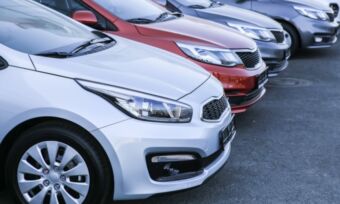Car loan options on Centrelink
It’s possible to take out a car loan while receiving Centrelink payments or benefits. Here’s our guide to what you may need to keep in mind for car loans on Centrelink.

It’s possible to take out a car loan while receiving Centrelink payments or benefits. Here’s our guide to what you may need to keep in mind for car loans on Centrelink.
KEY POINTS
- It’s possible to get a car loan while on Centrelink, but not all lenders may accept your application.
- Some types of Centrelink benefits may be accepted as income when applying for car loans, though others may not.
- Getting a guarantor or co-borrower could help improve your car loan application’s chance of approval, though there are risks involved.
If you need a car, but are one of the many Australians who partially or entirely relies on Services Australia (Centrelink) payments and benefits as income, you may be wondering whether you can take out a car loan. While it is indeed possible to do so, there may be challenges to keep in mind.
What is a car loan?
A car loan is a personal loan specifically for buying a vehicle, such as a car, ute or motorbike. If you need to purchase a vehicle but don’t have the necessary savings, you may be able to finance the purchase with a loan from a bank or another lender. You will then pay the loan balance back in instalments, plus interest and fees, until it is paid off.
There are two main types of car loans; secured and unsecured. A secured loan is guaranteed by an asset, typically the car itself. This means that if you do not meet your required payments on time, the lender may repossess the car and sell it.
An unsecured car loan (which is an unsecured personal loan) is not secured by any asset. The interest rate for an unsecured car loan is likely to be higher than it would be for a secured one, because the risk to the lender is greater, and you will likely not be able to borrow as much money.
A car lon may have a variable or fixed interest rate. A variable interest rate may change over the loan term based on market forces. Variable rates can also mean more flexibility for the borrower, as you’re more likely to be able to choose your repayment frequency and loan term, as well as make additional repayments to pay off your loan faster without a fee.
A fixed interest rate is guaranteed not to change for a certain period of time, typically up to five years. This helps keep your repayments consistent, and removes the risk of higher bills due to rising rates, though you may have fewer flexible payment options available to you. At the end of the loan term, if you are still paying the loan off (such as if you choose to include a balloon payment option), you can choose to set it at a new agreed rate, or change it to a variable rate.
Secured loans are typically used to finance the purchase of new cars up to to three years old, and used cars up to five or six years old. If a car is older than this, it may not qualify for a secured loan, in which case, you may need to apply for an unsecured loan to finance the purchase.
Keep in mind too that your credit score can affect the interest rate you are offered on a personal/car loan. Taking steps to improve your credit score may help put yourself in a stronger position to get a better interest rate.
Can you get a car loan on Centrelink?
Yes, it is possible to successfully apply for car loans while receiving Centrelink payments and benefits. There are, however, a number of minimum requirements that you must meet to be eligible for car loans on Centrelink, which are the same for any standard car loan.
For example, you must be over the age of 18, an Australian citizen or permanent resident, and earning a regular income. Many lenders will also consider your credit score, as well as the amount of money you have in savings and your living expenses, when you apply for a loan.
Regular income
One of the main eligibility requirements when applying for any loan is having a regular income. Even if your entire income comes from Centrelink payments, a lender may still deem you eligible for a car loan. Some payments, such as Austudy and Youth Allowance, will typically not be viewed as income by many lenders, as these are temporary assistance programs. Other types of payments that may be seen as income by some lenders for Centrelink car loans are:
- Veteran payments
- Age Pension payments
- Parenting payments
- Carer payments
- Family Tax Benefits
- Rent Assistance payments
- National Disability Insurance Scheme (NDIS) and Disability Pension payments
These types of government payments are usually given to support eligible Australian residents with specific living costs, based on a range of eligibility criteria. You should ensure that you are meeting any requirements that may apply if you plan on using any government support payments to help you finance a car or repay a car loan.
Credit score
Lenders will also consider your credit score when you apply for a car loan. If you have a high credit score—such as if you haven’t had any major credit mishaps like defaults or bankruptcies, and avoid paying your bills late—lenders are more likely to look at you favourably when offering you loans.
If you have a low or bad credit score, it may be harder to successfully apply for a loan. However, keep in mind that lenders will also consider other factors. For example, even if your credit score is low, lenders may consider your application more favourably if you have a regular income, low debts and a stable residential living situation. You can check your credit score for free with Canstar or via the Canstar app.
Under Australia’s responsible lending laws, lenders must only offer a loan if it is suitable for the borrower. This means the lender must make ‘reasonable inquiries’ about the applicant’s requirements and objectives, and take steps to verify their financial situation.
How do you get a car loan while on Centrelink?
If you want a car loan while on Centrelink benefits, you may want to consider your budget and borrowing power, find a suitable lender (perhaps with the assistance of a broker), and decide if you want to find someone willing to act as a guarantor for the loan, or even co-borrow with you.
Consider your budget and ask if a car loan is right for you
Before applying for a car loan, you may want to make a budget that includes your income and all your expenses, such as rent, bills and groceries. If repaying a car loan will likely mean financial stress, you may well consider whether it’s worth taking on this added financial burden. In some cases, if you do not need a car right now, you could try to save up to buy one outright later.
Consider your borrowing power
Your borrowing power is the highest amount a lender is prepared to approve you for when you apply for a loan. Your borrowing power is generally determined by your income, expenses and credit score, with lenders using this information to work out how big of a loan you can afford to pay back without it sending you into financial hardship. You can also make your own calculations using Canstar’s car loan calculator.
Get your documents in order
You will typically need to provide a lender with documents to support your loan application, so they can get a better idea of your needs and financial situation. The exact documents you’ll need may vary by lender, though you’ll often need to provide your last two or three bank statements, pay slips from your job (if you are working), and a Centrelink income statement.
Find an appropriate lender
If Centrelink payments are your sole income source, fewer lenders may be willing to approve your application, as they may consider the default risk to be too high. You may want to research which banks or individual lenders are willing to approve car loans specifically for people on Centrelink payments.
You may also be able to get help from a car loan broker. Brokers are typically familiar with a variety of loan products and lenders, and may be able to recommend one that is suitable for your needs. It can also be important to read the Product Disclosure Statement (PDS), Target Market Determination (TMD) and other relevant documentation for any loan products you are considering.
Consider if finding a guarantor or co-borrower is right for you
If you want to buy a car using a Centrelink car loan, one possible option might be to ask someone to act as a guarantor for you, or become a co-borrower on your loan. A guarantor is someone who is willing to ‘guarantee’ your loan, which is agreeing to take it over and pay off the balance in the event that you can not. A co-borrower is equally responsible for the loan as the main borrower from the beginning. Both of these options could help improve your car loan’s chance of approval, as they help reduce the lender’s financial risk.
A good guarantor (often a family member or friend) or co-borrower will typically have stable finances and a high credit score. It may be worthwhile for them to seek professional legal and financial advice before agreeing, as it can be risky for them. For example, if you are unable to meet your required repayments, your guarantor will be responsible for paying off the outstanding debt. This could put strain not only on their finances, but on their relationship with you.
Compare Car Loans with Canstar
If you’re currently considering a car loan, the comparison table below displays some of the car loans on our database with links to lenders’ websites that are available for used cars. This table is sorted by Star Rating (highest to lowest). Products shown are for a loan amount of $20,000 in NSW with a loan term of five years. Consider the Target Market Determination (TMD) before making a purchase decision. Contact the product issuer directly for a copy of the TMD. Use Canstar’s car loans comparison selector to view a wider range of car loan products. Canstar may earn a fee for referrals.
The comparison rates for car loans are based on credit of $30,000 and a term of 5 years, unsecured, unless otherwise stated.
^WARNING: This comparison rate is true only for the examples given and may not include all fees and charges. Different terms, fees or other loan amounts might result in a different comparison rate.
 24hr approval available
24hr approval available
 24hr approval available
24hr approval available
 24hr approval available
24hr approval available
Products displayed above that are not “Sponsored or Promoted” are sorted as referenced in the introductory text and then alphabetically by company. Canstar may receive a fee for referral of leads from these products. See How We Get Paid for further information.
Canstar is an information provider and in giving you product information Canstar is not making any suggestion or recommendation about a particular product. If you decide to apply for a car loan, you will deal directly with a financial institution, not with Canstar. Current rates and fees are displayed and may be different to what was rated. Rates and product information should be confirmed with the relevant financial institution. For more information, read our detailed disclosure, important notes and additional information. *Read the comparison rate warning. The results do not include all providers and may not compare all the features available to you. Canstar may earn a fee for referral of leads from the comparison table. See How We Get Paid.
Cover image source: Mikbiz/Shutterstock.com
This article was reviewed by our Finance Editor Jessica Pridmore before it was updated, as part of our fact-checking process.

The comparison rates for car loans are based on credit of $30,000 and a term of 5 years, unsecured, unless otherwise stated.
^WARNING: This comparison rate is true only for the examples given and may not include all fees and charges. Different terms, fees or other loan amounts might result in a different comparison rate.
 24hr approval available
24hr approval available
Try our Car Loans comparison tool to instantly compare Canstar expert rated options.






